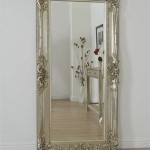How To Decorate A Mirror Frame With Rhinestones
Adding rhinestones to a mirror frame can elevate its aesthetic, transforming a simple mirror into a glamorous statement piece. This article provides a comprehensive guide on how to effectively embellish a mirror frame with rhinestones, covering material selection, application techniques, and design considerations.
Selecting the Right Materials
The success of a rhinestone-decorated mirror hinges on the quality of materials used. Choosing appropriate rhinestones and adhesive is crucial for a long-lasting and visually appealing result. Consider the following factors when selecting materials:
Rhinestone Type: Glass rhinestones offer superior sparkle and clarity compared to acrylic or plastic alternatives. However, acrylic rhinestones are generally more affordable and lightweight. Consider the overall look desired and the budget when selecting the rhinestone type. Various shapes and sizes are available, including round, square, marquise, and teardrop. Experimenting with different shapes can add visual interest to the design.
Adhesive: A strong, durable adhesive specifically designed for bonding rhinestones is essential. E6000 and Gem-Tac are popular choices known for their strong hold and resistance to temperature fluctuations. Avoid using general-purpose glues, as they may not adhere properly or might yellow over time, impacting the overall appearance of the finished project.
Frame Material: The frame material influences the type of adhesive required. Porous materials like wood may absorb certain adhesives, requiring a different formulation than smooth surfaces like glass or metal. Ensure the chosen adhesive is compatible with the frame material.
Preparing the Mirror Frame
Proper preparation ensures a smooth and successful rhinestone application. Cleaning the frame thoroughly removes dust and debris that could interfere with adhesion. Use a mild cleaning solution appropriate for the frame material and allow it to dry completely before proceeding.
If dealing with a painted or varnished frame, lightly sanding the surface can improve adhesion. Use fine-grit sandpaper and wipe away any dust generated during the sanding process. This creates a slightly textured surface for the adhesive to grip more effectively.
For intricate designs, consider sketching the pattern directly onto the frame using a pencil. This serves as a guide during the rhinestone application process, ensuring accuracy and symmetry in the final design.
Applying the Rhinestones
Applying the rhinestones methodically and with precision is crucial for achieving a polished and professional look. Consider the following techniques:
Individual Application: Using tweezers or a rhinestone applicator tool provides the most control when placing individual rhinestones. Apply a small dot of adhesive to the back of each rhinestone or directly onto the frame, carefully positioning the rhinestone according to the chosen design. Maintain consistent spacing between rhinestones for a uniform appearance.
Strip Application: Rhinestone strips, pre-arranged on a flexible backing, offer a quick and efficient way to cover larger areas. Cut the strips to the desired length and carefully adhere them to the frame, pressing firmly to ensure proper bonding. This technique is particularly useful for creating borders or straight lines.
Drying Time: Allow ample drying time for the adhesive to cure completely before handling or moving the mirror. Refer to the adhesive manufacturer's instructions for recommended drying times. Avoid touching the rhinestones during the drying process to prevent accidental displacement.
Design Considerations
Careful planning of the rhinestone design enhances the overall visual impact. Consider these design elements:
Pattern and Layout: Choose a pattern that complements the mirror's shape and style. Simple geometric patterns, swirling designs, or evenly spaced borders can all create striking effects. Experiment with different layouts before committing to a final design.
Rhinestone Size and Color: Varying rhinestone sizes and colors can add depth and dimension to the design. Larger rhinestones can serve as focal points, while smaller rhinestones fill in surrounding areas. Consider the existing décor and the desired ambiance when selecting rhinestone colors.
Frame Shape and Style: The frame's shape and style influence the design choices. A simple, rectangular frame might benefit from a minimalist border, while a more ornate frame could accommodate a more elaborate design. Consider the existing features of the frame when planning the rhinestone embellishments.

How To Make A Rhinestone Mirror 25 Diy

Rhinestone Encrusted Wall Mirror Glam Decor

Rhinestone Mirror Home Decor

Diy Rhinestone Vanity Mirror

Rhinestone Wall Mirror Custom Frame Diy

Diy Home Decor Bling Glam Wall Mirror

Jewel Encrusted Mirror Project Kristi Lyn Glass

Bling Mirror My Sister And I Made For Her Dorm Room Crafty Diy Dormdecor

Crystal Embellished Mirrors Mirror Frame Diy Glitter Decor Jewelry

Diy Rhinestone Vanity Mirror








